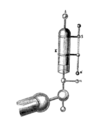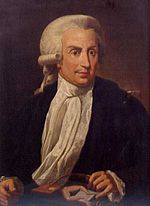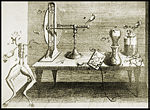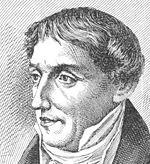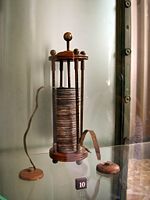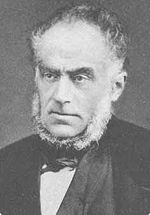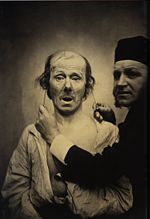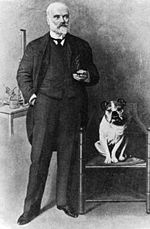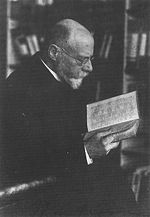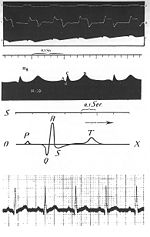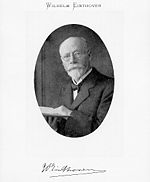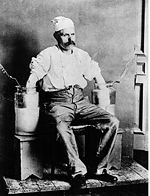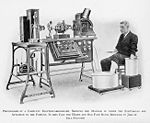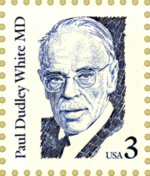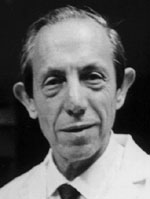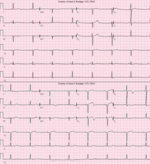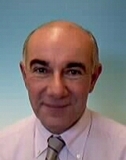A Concise History of the ECG: Difference between revisions
m (→1950 - to date) |
mNo edit summary |
||
| Line 4: | Line 4: | ||
|supervisor= | |supervisor= | ||
}} | }} | ||
{| class="wikitable" | {| class="wikitable" | ||
|This overview has been adapted from Dean Jenkins's and Stephen Gerred's [http://www.ecglibrary.com ECGlibary.com], for which they are gratefully acknowledged. | |This overview has been adapted from Dean Jenkins's and Stephen Gerred's [http://www.ecglibrary.com ECGlibary.com], for which they are gratefully acknowledged. | ||
Latest revision as of 22:25, 20 November 2016
| Author(s) | Dr Dean Jenkins & Dr. Stephen Gerred | |
| Moderator | J.S.S.G. de Jong | |
| Supervisor | ||
| some notes about authorship | ||
| This overview has been adapted from Dean Jenkins's and Stephen Gerred's ECGlibary.com, for which they are gratefully acknowledged. |
The history of the ECG goes back more than one and a half centuries.
1600 - 1800
1600. William Gilbert, Physician to Queen Elizabeth I, President of the Royal College of Physicians and creator of the 'magnetic philosophy', introduces the term 'electrica' for objects (insulators) that hold static electricity. He derives the word from the Greek for amber (electra). It has been known from ancient times that amber when rubbed could lift light materials. Gilbert adds other examples such as sulphur and describes what will later be known as 'static electricity' to distinguish it from the more noble magnetic force. He sees his ideas as part of a philosophy to replace forever the prevailing Aristotlean view of matter. [1]
1649. Sir Thomas Browne, Physician, while writing to dispel popular ignorance in many subjects, is the first to use the word 'electricity'. Browne calls the attractive force "Electricity, that is, a power to attract strawes or light bodies, and convert the needle freely placed". (He is also the first to use the word 'computer' - referring to people who compute calendars.)[2]
1660. Otto Von Guericke builds the first static electricity generator.
1662. The work of Rene Descartes, French Philosopher, is published (posthumously) and explains human movement in terms of a complex mechanical interaction of threads, pores, passages and 'animal spirits'. He has worked on his ideas in the 1630s but did not publish because of the persecution of other radical thinkers such as Galileo. William Harvey developed similar ideas but they were never published. [3]
1664. Jan Swammerdam, a Dutchman, disproves Descartes' mechanistic theory of animal motion by removing the heart of a living frog and showing that the frog is still able to swim. When the brain is removed all movement stops (which could be in keeping with Descarte's theory) but then, when the frog is dissected and a severed nerve end stimulated with a scalpel, the muscles twitch. This proves that movement of a muscle can occur without any connection to the brain.Therefore the transmission of 'animal spirits' is not necessary.
Swammerdam's ideas are not widely known and his work is not published until after his death. However, he writes many letters and his friend, Nicolaus Steno, attacks Cartesian ideas in a lecture in Paris in 1665. Boerhaave publishes Swammerdam's 'Book of Nature' in the 1730s.It is translated into English in 1758.
1668 Swammerdam refines his experiments on muscle contraction and nerve conduction. He demonstrates some of his work to notable figures such as the Grand-Duke Cosimo of Tuscany when the Grand Duke visits Swammerdam's father's house on the Oude Schans in Amsterdam. In one experiment he suspends a muscle on a brass hook inside a glass tube with a water droplet, to detect movement, and 'irritates' the nerve with a silver wire. This produces movement of the muscle, which may be due to the induction of a small electrical charge - although Swammerdam is unaware of this.
1729 Stephen Gray, English scientist, distinguishes between conductors and insulators of electricity. He demonstrates the transfer of static electrical charge to a cork ball across 150 meters of wet hemp thread. Later he finds that the transfer can be achieved over greater distances through brass wire.
1745 Dutch physicist Pieter van Musschenbroek discovers that a partly filled jar with a nail projecting from a cork in its neck can store an electrical charge. The jar is named the 'Leyden Jar' after the place of its discovery. Ewald Georg von Kliest of Pomerania invents the same device independently.
Using a Leyden jar in 1746, Jean-Antoine Nollet, French physicist and tutor to the royal family of France, sends an electrical current through 180 Royal Guards during a demonstration for King Louis XV.
1769 Edward Bancroft, an American scientist, suggests that the 'shock' from the torpedo fish is electrical rather than mechanical in nature. He shows that the properties of the shock are similar to those from a Leyden jar in that it can be conducted or insulated with appropriate materials. The torpedo fish and other species are widely known to deliver shocks and are often used for therapeutic reasons. However, electrical theory at this time dictates that electricity will always flow through conductors and diffuse away from areas of high charge to areas of low charge. Since living tissues are known to be conductors, it is impossible to imagine how an imbalance of charge can exist within an animal. Therefore animals can not use electricity for nerve conduction - or to deliver shocks. Furthermore, 'water and electricity do not mix' so the idea of an 'electric fish' is generally not accepted. [4]
1773 John Walsh, Fellow of the Royal Society and Member of Parliament, obtains a visible spark from the electric eel Electrophorus electricus. The eel is out of water, as it is not possible to produce the spark otherwise. Walsh uses thin strips of tin foil to demonstrate his technique to many colleagues and visitors at his house in London. Unfortunately, he never publishes his eel experiment, though he does win the Copley medal in 1774 and 1783 for his work. Walshes observations , and those of Bancroft before him, adds to the argument that some form of animal electricity. [5]
1774 The Rev. Mr Sowdon and Mr Hawes, apothecary, report on the surprising effects of electricity in a case report of recovery from sudden death published in the annual report of the newly founded Humane Society (now the Royal Humane Society). The Society develops from 'The Institution for Affording Immediate Relief to Persons Apparently Dead from Drowning'. It is "instituted in the year 1774, to protect the industrious from the fatal consequences of unforseen accidents; the young and inexperienced from being sacrificed to their recreations; and the unhappy victims of desponding melancholy and deliberate suicide from the miserable consequences of self-destruction."
A Mr Squires, of Wardour Street, Soho, lives opposite the house from which a three year old girl, Catherine Sophia Greenhill falls from a window on 16th July 1774. After the attending apothecary declares that nothing could be done for the child, Mr Squires, "with the consent of the parents very humanely tried the effects of electricity. At least twenty minutes had elapsed before he could apply the shock, which he gave to various parts of the body without any apparent success; but at length, upon transmitting a few shocks through the thorax, he perceived a small pulsation: soon after the child began to sigh, and to breathe, though with great difficulty. In about ten minutes she vomited: a kind of stupor, occasioned by the depression of the cranium, remained for some days, but proper means being used, the child was restored to perfect health and spirits in about a week.
"Mr. Squires gave this astonishing case of recovery to the above gentlemen, from no other motive than a desire of promoting the good of mankind; and hopes for the future that no person will be given up for dead, till various means have been used for their recovery."
Since it is clear she sustained a head injury, the electricity probably stimulated the child out of deep coma rather than providing cardiac defibrillation (see also 1788, Charles Kite). Annual Report 1774: Humane Society, London. pp 31-32
1775 Abildgaard shows that hens can be made lifeless with electrical impulses and he can restore a pulse with electrical shocks across the chest. "With a shock to the head, the animal was rendered lifeless, and arose with a second shock to the chest; however, after the experiment was repeated rather often, the hen was completely stunned, walked with some difficulty, and did not eat for a day and night; then later it was very well and even laid an egg." [6]
1786
Italian Anatomist Luigi Galvani notes that a dissected frog's leg twitches when touched with a metal scalpel. He has been studying the effects of electricity on animal tissues this summer.
On 20th September 1786 he wrote, "I had dissected and prepared a frog in the usual way and while I was attending to something else I laid it on a table on which stood an electrical machine at some distance from its conductor and separated from it by a considerable space. Now when one of the persons present touched accidentally and lightly the inner crural nerves of the frog with the point of a scalpel, all the muscles of the legs seemed to contract again and again as if they were affected by powerful cramps."
He later shows that direct contact with the electrical generator or the ground through an electrical conductor leads to a muscle contraction. Galvani also uses brass hooks attached to the frog's spinal cord and suspended from an iron railing in a part of his garden. He notices that the frogs' legs twitch during lightening storms and when the weather is fine. He interprets these results in terms of "animal electricity" or the preservation in the animal of "nerveo-electrical fluid" similar to that of an electric eel. He later also shows that electrical stimulation of a frog's heart leads to cardiac muscular contraction. Galvani. De viribus Electritatis in motu musculari Commentarius. 1791
Galvani's name is given to the 'galvanometer', an instrument for measuring (and recording) electricity - this is essentially what an ECG is; a sensitive galvanometer.
1788 Charles Kite wins the Silver Medal of the Humane Society (awarded at the first prize medal ceremony of the Society, co-judged with the Medical Society of London) with an essay on the use of electricity in the diagnosis and resuscitation of persons apparently dead. This essay is often cited as the first record of cardiac defibrillation, but the use of electricity suggested by Mr Kite is much different. For example, on describing a case of drowning from 1785, in which resuscitation was attempted with artificial respiration, warmth, tobacco, "volatiles thrown into the stomach, frictions, and various lesser stimuli" for nearly an hour, he then recalls the use of electricity. "Electricity was then applied, and shocks sent through in every possible direction; the muscles through which the fluid [electricity] passed were thrown into strong contractions." He concludes that electricity is a valuable tool that can be used to resuscitate a person who appeared dead. Annual Report 1788: Humane Society, London. pp 225-244. Kite C. An Essay on the Recovery of the Apparently Dead. 1788: C. Dilly, London.
1792 Alessandro Volta, Italian Scientist and inventor, attempts to disprove Galvani's theory of "animal electricity'" by showing that electrical current is generated by the combination of two dissimilar metals.
His assertion is that the electrical current comes from metals and not animal tissues. (We now know that both Galvani and Volta were right.) To prove his theory he develops the voltaic pile in 1800 (a column of alternating metal discs - zinc with copper or silver - separated by paperboard soaked in saline) which can deliver a substantial and steady current of electricity. Enthusiasm in the use of electricity leads to further attempts at reanimation of the dead with experiments on recently hanged criminals. Giovani Aldini (the nephew of Galvani) conducts an experiment at the Royal College of Surgeons in London in 1803. The executed criminal has lain in a temperature of 30 degrees F for one hour and is transported to the College. "On applying the conductors to the ear and to the rectum, such violent muscular contractions were executed, as almost to give the appearance of the reanimation". Aldini, J. Essai: Théorique et expérimental sur le Galvanisme, Paris (1804), Giovani Aldini. General Views on the Application of Galvanism to Medical Purposes Principally in cases of suspended Animation (London: J. Callow, Princes Street and Burgess and Hill, Great Windmill Street, 1819). Mary Shelly's Frankenstein is published in 1818. Louis Figuier, Les merveilles de la Science (Paris, 1867), p.653
1800 - 1895
1819 While demonstrating to students the heating of a platinum wire with electricity from a voltaic pile at the University of Copenhagen, Danish physicist Hans Christian Oersted notices that a nearby magnetized compass needle moves each time the electrical current is applied. He discovers electromagnetism, which is given a theoretical basis (with remarkable speed) by André Marie Ampère.
1820 Johann (Johan) Schweigger of Nuremberg increases the movement of magnetized needles in electromagnetic fields. He finds that wrapping the electric wire into a coil of 100 turns multiplies the effect on the needle. He proposes that a magnetic field revolved around a wire carrying a current. This was later proven by Michael Faraday. Schweigger announces his discovery at the University of Halle on 16th September 1820.
1825 Leopold Nobili, Professor of Physics at Florence, develops an 'astatic galvanometer'. Using two identical magnetic needles of opposite polarity, either fixed together with a figure of eight arrangement of wire loops (in earlier versions), or one movable needle with a wire loop and one with a scale (in later versions), Nobili is able to compensate for the effects of the earth's magnetic field. In 1827, using this instrument, he manages to detect the flow of current in the body of a frog from muscles to spinal cord. He detects the electricity running along saline-moistened cotton thread joining the dissected frog's legs in one jar to its body in another jar. Nobili feels that this work proves the theory of animal electricity.
1838 Carlo Matteucci, Professor of Physics at the University of Pisa, a student of Nobili, shows that an electric current accompanies each heart beat. He uses a preparation known as a 'rheoscopic frog', in which the cut nerve of a frog's leg is used as the electrical sensor and twitching of the muscle is used as the visual sign of electrical activity. He also uses Nobili's astatic galvanometer for the study of electricity in muscles, typically inserting one galvanometer wire into the open end of the dissected muscle and the other onto the surface of the muscle. He goes on to try to demonstrate conduction in nerve, but is unable to do so (since his galvanometers are not sensitive enough). [7]
1840 Dr Golding Bird, a physician, accomplished chemist and member of the London Electrical Society, opens an electrical therapy room at Guy's Hospital, London, treating a large range of diseases. Although the application of electricity is popular, it is not considered a subject worthy of serious investigation. Because of Bird's reputation as a researcher, electrical therapy achieves popularity among London physicians, including his mentor, Dr Thomas Addison. [8]
1843 German physiologist Emil Du Bois-Reymond describes an "action potential" accompanying each muscular contraction. He detects the small voltage potential present in resting muscle and notes that this diminishes with contraction of the muscle. To accomplish this he had develops one of the most sensitive galvanometers of his time. His device has a wire coil with over 24,000 turns - 5 km of wire. Du Bios Reymond devises a notation which he called the 'disturbance curve' for his galvanometer. "O" was the stable equilibrium point of the astatic galvanometer needle and p, q, r and s (and also k and h) were other points in its deflection. Du Bois-Reymond, E. Untersuchungen uber thierische Elektricitat. Reimer, Berlin: 1848.
1850 Bizarre unregulated actions of the ventricles (later called ventricular fibrillation) is described by Hoffa during experiments with strong electrical currents across the hearts of dogs and cats. He demonstrates that a single electrical pulse can induce fibrillation. [9]
1856 Rudolph von Koelliker and Heinrich Muller confirm that an electrical current accompanies each heart beat by applying a galvanometer to the base and apex of an exposed ventricle. They also apply a nerve-muscle preparation, similar to Matteucci's, to the ventricle and observe that a twitch of the muscle occurs just prior to ventricular systole, followed by a much smaller twitch after systole. These twitches will later be recognized as caused by the electrical currents of the QRS and T waves. von Koelliker A, Muller H. Nachweis der negativen Schwankung des Muskelstroms am naturlich sich kontrahierenden Herzen. Verhandlungen der Physikalisch-Medizinischen Gesellschaft in Wurzberg. 1856;6:528-33.
1858 William Thompson (Lord Kelvin), professor of natural philosophy at Glasgow University, invents the 'mirror galvanometer' for the reception of transatlantic telegraph transmissions. A small, freely rotating mirror, with magnets stuck to its back, is suspended in a fine copper coil and a reflected spot of light from this mirror 'amplifies' small movements when electrical current is present. The whole apparatus is suspended in an air chamber and the pressure inside can be adjusted to vary the damping seen on the signals. This galvanometer is sensitive enough for transatlantic telegraphy.
1867 Thompson improves telegraph transmissions with the 'Siphon Recorder'. Before d'Arsonval (1880), Thompson uses a fine coil suspended in a strong magnetic magnetic field. Attached to the coil but isolated from it by ebonite (an insulator) is a siphon of ink. The siphon is charged with high voltage so that the ink is sprayed onto the paper, which moved over a metal surface. The siphon recorder could therefore not only detect currents; it could also record them onto paper.
1869-70 Alexander Muirhead, an electrical engineer and pioneer of telegraphy, possibly records a human electrocardiogram at St Bartholomew's Hospital, London but this is disputed. He is thought to have used a Thompson Siphon Recorder. Elizabeth Muirhead, his wife, writes a book of his life, claiming that he refrained from publishing his own work for fear of misleading others. Elizabeth Muirhead. Alexander Muirhead 1848 - 1920. Oxford, Blackwell: privately printed 1926.
1872 French physicist Gabriel Lippmann invents a capillary electrometer. It is a thin glass tube with a column of mercury beneath sulfuric acid. The mercury meniscus moves with varying electrical potential and is observed through a microscope.
1872 Mr Green, a surgeon, publishes a paper on the resuscitation of a series of patients who suffered cardiac and/or respiratory arrest during anesthesia with chloroform. He uses a galvanic pile (battery) of 200 cells generating 300 Volts, which he applies to the patient as follows "One pole should be applied to the neck and the other to the lower rib on the left side." Green T. On death from chloroform: its prevention by galvanism. Br Med J 1872 1: 551-3. Although this has been reported as an example of cardiorespiratory resuscitation, it is unclear what the exact mechanism seems to be. It is unlikely to be electric cardioversion or external pacing. It seems to be another example of electrophrenic stimulation (See also Duchenne 1872).
1872 Guillaume Benjamin Amand Duchenne de Boulogne, pioneering neurophysiologist, describes the resuscitation of a drowned girl with electricity in the third edition of his textbook on the medical uses of electricity. This episode has sometimes been described as the first 'artificial pacemaker' but he used an electrical current to induce electrophrenic rather than myocardial stimulation. Duchenne GB. De l'electrisation localisee et de son application a la pathologie et la therapeutique par courants induits at par courants galvaniques interrompus et continus. [Localised electricity and its application to pathology and therapy by means of induced and galvanic currents, interrupted and continuous] 3ed. Paris. JB Bailliere et fils; 1872
1874 A. Vulpian described mouvement fibrillaire in his article published in 1874, which would be the basis for the name ventricular fibrillation now used for this arrhythmia.[10]
1875 Richard Caton, a Liverpool physician, presents to the British Medical Association in July 1875 in Edinburgh. Using a Thompson 'mirror galvanometer' in animals he shows it is possible to detect 'feeble currents of varying direction ... when the electrodes are placed on two points of the external surface, or one electrode on the grey matter and one on the surface of the skull'. This is the first report of the EEG (or electroencephalogram). Caton was proving another Physician's hypothesis, John Hughlings Jackson, who suggested in 1873 that epilepsy was due to excessive electrical activity in the grey matter of the brain. Caton R: The electric currents of the brain. BMJ 1875; 2:278, Mumenthaler, Mattle Eds. Neurology. 4th Edition. Stuttgart, Thieme: 2004.
1876 Marey uses the electrometer to record the electrical activity of an exposed frog's heart. Marey EJ. Des variations electriques des muscles et du couer en particulier etudies au moyen de l'electrometre de M Lippman. Compres Rendus Hebdomadaires des Seances de l'Acadamie des sciences 1876;82:975-977
1878 British physiologists John Burden Sanderson and Frederick Page record the heart's electrical current with a capillary electrometer and shows it consists of two phases (later called QRS and T). Burdon Sanderson J. Experimental results relating to the rhythmical and excitatory motions of the ventricle of the frog. Proc R Soc Lond 1878;27:410-414
1880 French physicist Arsène d'Arsonval in association with Marcel Deprez, improves the galvanometer. Instead of a magnetized needle moving when electrical current flows through a surrounding wire coil the Deprez-d'Arsonval galvanometer has a fixed magnet and moveable coil. If a pointer is attached to the coil it can move over a suitably calibrated scale. The d'Arsonval galvanometer is the basis for most modern galvanometers. Comptes rendus de l'Académie des sciences, 1882, 94: 1347-1350
1884 John Burden Sanderson and Frederick Page publish some of their recordings. Burdon Sanderson J, Page FJM. On the electrical phenomena of the excitatory process in the heart of the tortoise, as investigated photographically. J Physiol (London) 1884;4:327-338
1887 British physiologist Augustus D. Waller of St Mary's Medical School, London publishes the first human electrocardiogram. It is recorded with a capilliary electrometer from Thomas Goswell, a technician in the laboratory. [11] This is shortly after the "Cruelty to Animals Act" is accepted in the British parliament, which leads to questions in the House of Commons.
Q. 'At a converzaione [sic] of the Royal Society at Burlington House on May 12th last, a bulldog was cruelly treated when a leather strap with sharp nails was wound around his neck and his feet were immersed in glass jars containing salts in solution, and the jars in turn were connected with wires to galvanometers. Such a cruel procedure should surely be dealt with under the "Cruelty to Animals Act" of 1876?'
A. 'The dog in question wore a leather collar ornamented with brass studs, and he was placed to stand in water to which some sodium chloride had been added, or in other words, common salt. If my honourable friend had ever paddled in the sea, he will appreciate fully the sensation obtained thereby from this simple pleasurable experience!'
1887 McWilliam provides the first detailed description of VF, and demonstrated how VF in man can be terminated by electric shocks applied through a large pair of electrodes; the first description of defibrillation in man.[12][13]
1889 Dutch physiologist Willem Einthoven sees Waller demonstrate his technique at the First International Congress of Physiologists in Bale. Waller often demonstrated by using his dog "Jimmy" who would patiently stand with paws in glass jars of saline.
1890 GJ Burch of Oxford devises an arithmetical correction for the observed (sluggish) fluctuations of the electrometer. This allows the true waveform to be seen, but only after tedious calculations. [14]
1891 British physiologists William Bayliss and Edward Starling of University College London improve the capillary electrometer. They connect the terminals to the right hand and to the skin over the apex beat and show a "triphasic variation accompanying (or rather preceding) each beat of the heart". These deflections are later called P, QRS and T. [15] and [16] They also demonstrate a delay of about 0.13 seconds between atrial stimulation and ventricular depolarisation (later called PR interval). On the electromotive phenomena of the mammalian heart. Proc Phys Soc (21st March) in J Physiol (London) 1891;12:xx-xxi
1893 Willem Einthoven introduces the term 'electrocardiogram' at a meeting of the Dutch Medical Association. (Later he claims that Waller was first to use the term). Einthoven W: Nieuwe methoden voor clinisch onderzoek [New methods for clinical investigation]. Ned T Geneesk 29 II: 263-286, 1893
1895 - 1949
1895 Einthoven, using an improved electrometer and a correction formula developed independently of Burch, distinguishes five deflections which he names P, Q, R, S and T. [17]
Why PQRST and not ABCDE? The four deflections prior to the correction formula are labeled ABCD and the 5 derived deflections are labeled PQRST. The choice of P is a mathematical convention (as used also by Du Bois-Reymond in his galvanometer's 'disturbance curve' 50 years previously) by using letters from the second half of the alphabet. N has other meanings in mathematics and O is used for the origin of the Cartesian coordinates. In fact Einthoven uses O ..... X to mark the time line on his diagrams. P is simply the next letter. A lot of work has been undertaken to reveal the true electrical waveform of the ECG by eliminating the damping effect of the moving parts in the amplifiers and using correction formulae. If you look at the diagram in Einthoven's 1895 paper you will see how close it is to the string galvanometer recordings and the electrocardiograms we see today. The image of the PQRST diagram may be striking enough to be adopted by the researchers as a true representation of the underlying form. It would then be logical to continue the same naming convention when the more advanced string galvanometer starts creating electrocardiograms a few years later.
1897 Clement Ader, a French electrical engineer, reports his amplification system for detecting Morse code signals transmitted along undersea telegraph lines. It is never intended to be used as a galvanometer. Einthoven later quotes Ader's work but seems to have developed his own amplification device independently. [18]
1899 Karel Frederik Wenckebach publishes a paper "On the analysis of irregular pulses" describing impairment of AV conduction leading to progressive lengthening and blockage of AV conduction in frogs. This will later be called Wenckebach block (Mobitz type I) or Wenckebach phenomenon.
1899 Jean-Louis Prevost, Professor of Biochemistry, and Frederic Batelli, Professor of Physiology, both of Geneva, discover that large electrical voltages applied across an animal's heart can stop ventricular fibrillation. [19]
1901 Einthoven invents a new galvanometer for producing electrocardiograms using a fine quartz string coated in silver, based on ideas by Deprez and d'Arsonval (who used a wire coil). His "string galvanometer" weighs 600 pounds. Einthoven acknowledges the similar system by Ader but later (1909) calculates that his galvanometer is in fact many thousands of times more sensitive. [20]
1902 Einthoven publishes the first electrocardiogram recorded on a string galvanometer. [21]
1903 Einthoven discusses commercial production of a string galvanometer with Max Edelmann of Munich and Horace Darwin of Cambridge Scientific Instruments Company of London. 1905
Einthoven starts transmitting electrocardiograms from the hospital to his laboratory 1.5 km away via telephone cables. On March 22nd the first 'telecardiogram' is recorded from a healthy and vigorous man and the tall R waves are attributed to his cycling from laboratory to hospital for the recording.
1905 John Hay, of Liverpool, publishes pressure recordings from a 65 year old man. The recording shows heart block in which AV conduction does not seem to be impaired, since the a-c intervals on the jugular venous waves is unchanged in the conducted beats. This is the first demonstration of what we now call Mobitz type II AV block. [22]
1906 Einthoven publishes the first organised presentation of normal and abnormal electrocardiograms recorded with a string galvanometer. Left and right ventricular hypertrophy, left and right atrial hypertrophy, the U wave (for the first time), notching of the QRS, ventricular premature beats, ventricular bigeminy, atrial flutter and complete heart block are all described. Einthoven W. Le telecardiogramme. Arch Int de Physiol 1906;4:132-164 (translated into English. Am Heart J 1957;53:602-615)
1906 Cremer records the first oesophageal electrocardiogram which he achieved with the help of a professional sword swallower. Oesophageal electrocardiography later developed in the 1970s to help differentiate atrial arrhythmias. He also records the first fetal electrocardiogram from the abdominal surface of a pregnant woman. Cremer. Ueber die direkte Ableitung der Aktionströme des menslichen Herzens vom Oesophagus und über das Elektrokardiogramm des Fötus. Munch. Med. Wochenschr. 1906;53:811
1907 Arthur Cushny, professor of pharmacology at University College London, publishes the first case report of atrial fibrillation. His patient was 3 days post-op following surgery on an "ovarian fibroid" when she developed a "very irregular" pulse at a rate of 120 - 160 bpm. Her pulse was recorded with a "Jacques sphygmochronograph" which shows the radial pulse pressure against time - much like the arterial line blood pressure recordings used in Intensive Care today. Cushny AR, Edmunds CW. Paroxysmal irregularity of the heart and auricular fibrillation. Am J Med Sci 1907;133:66-77.
1908 Edward Schafer of the University of Edinburgh is the first to buy a string galvanometer for clinical use.
1909 Thomas Lewis, of University College Hospital, London, buys a string galvanometer and so does Alfred Cohn of Mt Sinae Hospital, New York. Thomas Lewis publishes a paper in the BMJ detailing his careful clinical and electrocardiographic observations of atrial fibrillation. At one point Lewis identifies a fibrillating horse's heart using the string galvanometer's electrocardigram recording. He then followed the horse to the slaughterhouse, where he could visually confirm the fibrillating atrium. [23]
1909 Nicolai and Simmons report on the changes to the electrocardiogram during angina pectoris. Nicolai DF, Simons A. (1909) Zur klinik des elektrokardiogramms. Med Kiln 5;160
1910 Walter James, Columbia University and Horatio Williams, Cornell University Medical College, New York, publish the first American review of electrocardiography. It describes ventricular hypertrophy, atrial and ventricular ectopics, atrial fibrillation and ventricular fibrillation. The recordings were sent from the wards to the electrocardiogram room by a system of cables. There is a great picture of a patient having an electrocardiogram recorded with the caption "The electrodes in use".James WB, Williams HB. The electrocardiogram in clinical medicine. Am J Med Sci 1910;140:408-421, 644-669
1911 Levy & Lewis demonstrate that when VF occurred during chloroform anesthesia, it was often preceded by the appearance of multiform ventricular premature beats or ventricular tachycardia.[23]
Thomas Lewis publishes a classic textbook. The mechanism of the heart beat. London: Shaw & Sons and dedicates it to Willem Einthoven.
1912 Einthoven addresses the Chelsea Clinical Society in London and describes an equilateral triangle formed by his standard leads I, II and III later called 'Einthoven's triangle'. This is the first reference in an English article to the abbreviation 'EKG' that I have seen.Einthoven W. The different forms of the human electrocardiogram and their signification. Lancet 1912(1):853-861
Hoffman published the first ECG of ventricular fibrillation in man.[24]
1918 Bousfield describes the spontaneous changes in the electrocardiogram during angina. [25]
1920 Hubert Mann of the Cardiographic Laboratory, Mount Sinai Hospital, describes the derivation of a 'monocardiogram', later to be called 'vectorcardiogram'. [26]
1920 Harold Pardee, New York, publishes the first electrocardiogram of an acute myocardial infarction in a human and describes the T wave as being tall and "starts from a point well up on the descent of the R wave". [27]
1924 Willem Einthoven wins the Nobel prize for inventing the electrocardiograph.
1924 Woldemar Mobitz publishes his classification of heart blocks (Mobitz type I and type II) based on the electrocardiogram and jugular venous pulse waveform findings in patients with second degree heart block. Mobitz W. Uber die unvollstandige Storung der Erregungsuberleitung zwischen Vorhof und Kammer des menschlichen Herzens. (Concerning partial block of conduction between the atria and ventricles of the human heart). Z Ges Exp Med 1924;41:180-237.
1926 A doctor from the Crown Street Women's Hospital in Sydney, who wishes to remain anonymous, resuscitates a new-born baby with an electrical device later called a 'pacemaker'. The doctor wants to remain anoymous because of the controversy surrounding research that artificially extends human life.
1928 Ernstine and Levine report the use of vacuum tubes to amplify the electrocardiogram instead of the mechanical amplification of the string galvanometer. [28]
1928 Frank Sanborn's company (founded 1917 and acquired by Hewlett-Packard in 1961 and since 1999, Philips Medical Systems) converts their table model electrocardiogram machine into their first portable version weighing 50 pounds and powered by a 6-volt automobile battery.
1929 Sydney doctor Mark Lidwill, physician, and Edgar Booth, physicist, report the electrical resuscitation of the heart to a meeting in Sydney. Their portable device uses an electrode on the skin and a transthoracic catheter. Edgar Booth's design could deliver a variable voltage and rate and is employed to deliver 16 volts to the ventricles of a stillborn infant.
1930 Wolff, Parkinson and White report an electrocardiographic syndrome of short PR interval, wide QRS and paroxysmal tachycardias. Wolff L, Parkinson J, White PD. Bundle branch block with short P-R interval in healthy young people prone to paroxysmal tachycardia. Am Heart J 1930;5:685. Later, when other published case reports are examined for evidence of pre-excitation,earlier examples of 'Wolff Parkinson White' syndrome, which were not recognized as a clinical entity at the time, are identified. The earliest example was published by Hoffmann in 1909. Von Knorre GH. The earliest published electrocardiogram showing ventricular preexcitation. Pacing Clin Electrophysiol. 2005 Mar;28(3):228-30
1930 Sanders first describes infarction of the right ventricle. [29]
1931 Charles Wolferth and Francis Wood describe the use of exercise to provoke attacks of angina pectoris. They investigate the ECG changes in normal subjects and those with angina, but dismissed the technique as too dangerous "to induce anginal attacks indiscriminately". [30]
1931 Dr Albert Hyman patents the first 'artificial cardiac pacemaker', which stimulates the heart by using a transthoracic needle. His aim is to produce a device that is small enough to fit in a doctor's bag and be able to stimulate the right atrial area of the heart with a suitably insulated needle. His experiments are on animals. His original machine was powered by a crankshaft (it is later prototyped by a German company but is never successful). "By March 1, 1932 the artificial pacemaker had been used about 43 times, with a successful outcome in 14 cases." It is not until 1942 that a report of its successful short term use in Stokes-Adams attacks is presented. [31]
1932 Goldhammer and Scherf propose the use of the electrocardiogram after moderate exercise as an aid to the diagnosis of coronary insufficiency. Goldhammer S, Scherf D. Elektrokardiographische untersuchungen bei kranken mit angina pectoris. Z Klin Med 1932;122:134
1932 Charles Wolferth and Francis Wood describe the clinical use of chest leads. Wolferth CC, Wood FC. The electrocardiographic diagnosis of coronary occlusion by the use of chest leads. Am J Med Sci 1932;183:30-35
1934 By joining the wires from the right arm, left arm and left foot with 5000 Ohm resistors Frank Wilson defines an 'indifferent electrode' later called the 'Wilson Central Terminal'. The combined lead acts as an earth and is attached to the negative terminal of the ECG. An electrode attached to the positive terminal then becomes 'unipolar' and can be placed anywhere on the body. Wilson defines the unipolar limb leads VR, VL and VF where 'V' stands for voltage (the voltage seen at the site of the unipolar electrode). [32]
1935 McGinn and White describe the changes to the electrocardiogram during acute pulmonary embolism, including the S1 Q3 T3 pattern. [33]
1938 The American Heart Association and the Cardiac Society of Great Britain define the standard positions and wiring, of the chest leads V1 - V6. The 'V' stands for voltage. Barnes AR, Pardee HEB, White PD. et al. Standardization of precordial leads. Am Heart J 1938;15:235-239
1938 Tomaszewski notes changes to the electrocardiogram in a man who died of hypothermia. Tomaszewski W. Changements electrocardiographiques observes chez un homme mort de froid. Arch Mal Coeur 1938;31:525.
1939 Langendorf reports a case of atrial infarction discovered at autopsy. In retrospect,it could have been diagnosed by changes on the ECG. [34]
1940 Neuton Stern (student of Lewis)describes and names the "take off, or junction of the R-T (S-T) segment" as the J-point. Am Heart J 1940;20:355-356.
1942 Emanuel Goldberger increases the voltage of Wilson's unipolar leads by 50% and creates the augmented limb leads aVR, aVL and aVF. When they are added to Einthoven's three limb leads and the six chest leads, the 12 lead ECG that we know today emerges.
1942 Arthur Master standardizes the two step exercise test (now known as the Master two-step) for cardiac function. Master AM, Friedman R, Dack S. The electrocardiogram after standard exercise as a functional test of the heart. Am Heart J. 1942;24:777
1944 Young and Koenig report deviation of the P-R segment in a series of patients with atrial infarction. Young EW, Koenig BS. Auricular infarction. Am Heart J. 1944;28:287.
1947 Gouaux and Ashman describe an observation that helps differentiate aberrant conduction from ventricular tachycardia. The 'Ashman phenomenon' occurs when a stimulus takes place during the relative or absolute refractory period of the ventricles and the aberrancy is more pronounced. In atrial fibrillation with aberrant conduction, this is demonstrated when the broader complexes are seen terminating a relatively short cycle that follows a relatively long one. The QRS terminating the shorter cycle is conducted 'more aberrantly' because it falls in the refractory period. The aberrancy is usually of an RBBB pattern. [35]
1947 Claude Beck, a pioneering cardiovascular surgeon in Cleveland, successfully defibrillates a human heart during cardiac surgery. The patient is a 14 year old boy - 6 other patients have failed to respond to the defibrillator. His prototype defibrillator follows experiments on defibrillation performed on animals by Carl J. Wiggers, professor of physiology at the Western Reserve University. [36]
1948 Rune Elmqvist, Swedish engineer who had trained as a doctor but never practiced, introduces the first ink jet printer for the transcription of analog physiological signals. He demonstrates its use in the recording of ECGs at the First International Congress of Cardiology in Paris in 1950. The machine (the mingograph) was developed by him at the company that later became Siemens. (Luderitz, 2002)
1949 Montana physician Norman Jeff Holter develops a 75 pound backpack that can record the ECG of the wearer and transmit the signal. His system, the Holter Monitor, is later greatly reduced in size, combined with tape / digital recording and used to record ambulatory ECGs. [37]
1950 - to date
1949 Sokolow and Lyon propose diagnostic criteria for left ventricular hypertrophy i.e. LVH is present if the sum of the size of the S wave in V1 plus the R wave in V6 exceeds 35 mm. [38]
1950 John Hopps, a Canadian electrical engineer and researcher for the National Research Council, together with two physicians (Wilfred Bigelow, MD of the University of Toronto and his trainee, John C. Callaghan, MD) show that a coordinated heart muscle contraction can be stimulated by an electrical impulse delivered to the sino-atrial node. The apparatus, the first cardiac pacemaker, measures 30cm, runs on vacuum tubes and is powered by household 60Hz electrical current. [39]
1953 Osborn, while experimenting with hypothermic dogs, describes the prominent J (junctional) wave, often known as the "Osborn wave". He found the dogs were more likely to survive if they had an infusion of bicarbonate and supposed the J wave was due to an injury current caused by acidosis. Osborn JJ. Experimental hypothermia: respiratory and blood pH changes in relation to cardiac function. Am J Physiol 1953;175:389.
1955 Richard Langendorf publishes the "rule of bigeminy" whereby ventricular bigeminy tends to perpetuate itself. Langendorf R, Pick A, Winternitz M. Mechanisms of intermittent ventricular bigeminy. I. Appearence of ectopic beats dependent upon the length of the ventricular cycle, the "rule of bigeminy." circulation 1955;11:442.
1956 Paul Zoll, a cardiologist, uses a more powerful defibrillator and performs closed-chest defibrillation in a human. [40]
1957 Anton Jervell and Fred Lange-Nielsen of Oslo describe an autosomal recessive syndrome of long-QT interval, deafness and sudden death later known as the Jervell-Lange-Nielsen syndrome. [41]
1958 Professor Ake Senning, of Sweden, places the first implantable cardiac pacemaker designed by Rune Elmqvist into a 43-year-old patient with complete heart block and syncope (Arne Larsson).
1959 Myron Prinzmetal describes a variant form of angina in which the ST segment is elevated rather than depressed. [42]
1960 Smirk and Palmer highlight the risk of sudden death from ventricular fibrillation; particularly when ventricular premature beats occur at the same time as the T wave. The 'R on T' phenomenon. Smirk FH, Palmer DG. A myocardial syndrome, with particular reference to the occurrence of sudden death and of premature systoles interrupting antecedent T waves. Am J Cardiol 1960;6:620.
1963 Italian pediatrician C. Romano and Irish pediatrician O. Conor Ward (the following year) independently report an autosomal dominant syndrome of long-QT interval later known as the Romano-Ward syndrome. [43][44]
1963 Robert Bruce and colleages describe their multistage treadmill exercise test, later known as the Bruce Protocol. "You would never buy a used car without taking it out for a drive and seeing how the engine performed while it was running," Bruce says, "and the same is true for evaluating the function of the heart." [45][46]
1963 Baule and McFee are the first to detect the magnetocardiogram, the electromagnetic field produced by the electrical activity of the heart. The method can detect the ECG without the use of skin electrodes. Although potentially a useful technique, it has never gained clinical acceptance, partly because of its expense. [47]
1966 Mason and Likar modify the 12-lead ECG system for use during exercise testing. The right arm electrode is placed at a point in the infraclavicular fossa medial to the border of the deltoid muscle, 2 cm below the lower border of the clavicle. The left arm electrode is placed similarly on the left side. The left leg electrode is placed at the left iliac crest. Although this system reduces the variability in the ECG recording during exercise, it is not exactly equivalent to the standard lead positions. The Mason-Likar lead system tends to distort the ECG with a rightward QRS axis shift, a reduction in R wave amplitude in lead I and aVL, and a significant increase in R wave amplitude in leads II, III and aVF. [48]
1966 François Dessertenne of Paris publishes the first case of 'Torsade de pointes' Ventricular Tachycardia. [49]
1968 Journal of Electrocardiography, the Official Journal of the International Society for Computerized Electrocardiology and the International Society of Electrocardiology, is founded by Zao and Lepeschkin.
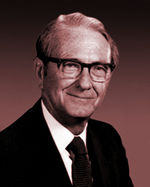
1968 Henry J. L. "Barney" Marriott MD, FACP, FACC introduces the modified CL [1] ("MCL") system (M for modified, C for chest and L for left arm) for constant monitoring of patients in coronary intensive care units. [50][51][52][53]
1969 Rosenbaum reviews the classification of ventricular premature complexes and adds a benign form that arises from the right ventricle and is not associated with heart disease. This becomes known as the 'Rosenbaum ventricular extrasystole'. [54]
1974 Jay Cohn, of University of Minnesota Medical School, describes the 'syndrome of right ventricular dysfunction in the setting of acute inferior wall myocardial infarction'. [55]
1974 Gozensky and Thorne introduce the term 'Rabbit ears' to electrocardiography. Rabbit ears describe the appearence of the QRS complex in lead V1 with an rSR' pattern (good rabbit) being typical of Right Bundle Branch Block and an RSr' (bad rabbit) suggesting a ventricular origin i.e. ventricular ectopy / tachycardia. [56]
1976 Erhardt and colleagues describe the use of a right-sided precordial lead in the diagnosis of right ventricular infarction which has previously been thought to be electrocardiographically silent. [57]
1982 Hein J. J. Wellens, et al. first described two electrocardiographic patterns that were predictive of tight, critical stenosis of the proximal left anterior descending (LAD) coronary artery and were subsequently termed Wellens' syndrome. [58]
1988 Professor John Pope Boineau of Washington University School of Medicine publishes a 30-year perspective on the modern history of electrocardiography. [59]
1992 Pedro Brugada and Joseph Brugada of Barcelona publish a series of 8 cases of sudden death, Right Bundle Branch Block pattern and ST elevation in V1 - V3 in apparently healthy individuals. This 'Brugada Syndrome' may account for 4-12% of unexpected sudden deaths and is the commonest cause of sudden cardiac death in individuals aged under 50 years in South Asia. The technology of the electrocardiogam, which is over 100 years old, can still be used to discover new clinical entities in cardiology. [60]
1992 Cohen and He describe a new non-invasive approach to map cardiac electrical activity accurately by using the surface Laplacian map of the body surface electrical potentials. [61]
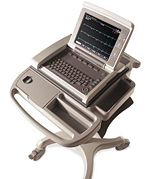
1993 Robert Zalenski, Professor of Emergency Medicine, Wayne State University, Detroit, and colleagues publish an influential article on the clinical use of the 15-lead ECG which routinely uses V4R, V8 and V9 in the diagnosis of acute coronary syndromes. Like the addition of the 6 standardised unipolar chest leads in 1938, the addition of the three new leads increases the sensitivity of the electrocardiogram in detecting myocardial infarction. [62]
1999 Researchers from Texas show that 12-lead ECGs transmitted via wireless technology to hand-held computers is feasible and can be interpreted reliably by cardiologists. [63]
2000 Physicians from the Mayo Clinic describe a new hereditary form of Short QT syndrome associated with syncope and sudden death, that they discovered in 1999. Several genes have since been implicated. [64]
2005 Danish cardiologists report the successful reduction in the time between onset of chest pain and primary angioplasty when the ECG of patients is transmitted wirelessly from ambulance to the cardiologist's handheld PDA (Personal Digital Assistant). The clinician can make an immediate decision to redirect patients to the catheter lab, saving time in transfers between hospital departments. [65]
2008 Dr. Haïssaguerre et al. study ECGs from patients with idiopathic ventricular fibrillation and find that patients with early repolarization on their ECG (elevation of the QRS-ST junction of at least 0.1 mV from baseline, which is usually considered a benign finding) is associated with a doubled risk of ICD (implantable cardioverter defibrillator) shock during follow up. [66]
2010 Dr. Sinner et al. studied ECGs in the general population. 13.1% of these had an early repolarization pattern, which was associated with a 2-5 fold risk of sudden death among individuals between 35 and 54 years of age. [67]
External Links
- ECG history on ECGlibrary.com
- History of electrophysiology on the website of the Heart Rhythm Society
References
-
Gilbert W. De Magnete, magneticisique corporibus, et de magno magnete tellure. 1600
-
Browne, Sir Thomas. Pseudodoxia Epidemica: Or, enquiries Into Very Many Received Tenents, and Commonly Presumed Truths. 1646: Bk II, Ch. 1. London
-
Descartes R. De Homine (Treatise of Man); 1662: Moyardum & leffen, Leiden.
-
Bancroft, E. An essay on the natural history of Guiana, London:T. Becket and P. A. de Hondt, 1769.
-
Walsh, J. On the electric property of torpedo: in a letter to Ben. Franklin. Phil. Trans. Royal Soc. 1773;63:478-489
-
Abildgaard, Peter Christian. Tentamina electrica in animalibus. Inst Soc Med Havn. 1775; 2:157-61.
-
Matteucci C. Sur un phenomene physiologique produit par les muscles en contraction. Ann Chim Phys 1842;6:339-341
-
Bird G. Lectures on Electricity and Galvanism, in their physiological and therapeutical relations, delivered at the Royal College of Physicians, in March, 1847 (Wilson & Ogilvy, London, 1847)
-
Hoffa M, Ludwig C. 1850. Einige neue versuche uber herzbewegung. Zeitschrift Rationelle Medizin, 9: 107-144
-
Hoffa M, Ludwig C. 1850. Einige neue versuche uber herzbewegung. Zeitschrift Rationelle Medizin, 9: 107-144
-
Vulpian A. 1874. Notes sur les éffets de la faradisation directe des ventricules du coeur chez le chien. Arch. Physiol. Norm. Path. 6: 975– 82
-
Waller AD. A demonstration on man of electromotive changes accompanying the heart's beat. J Physiol (London) 1887;8:229-234
-
Waller AD. A demonstration on man of electromotive changes accompanying the heart's beat. J Physiol (London) 1887;8:229-234
- McWilliam JA. Fibrillar Contraction of the Heart. J Physiol. 1887 Oct;8(5):296-310. DOI:10.1113/jphysiol.1887.sp000261 |
-
McWilliam JA. Electrical stimulation of the heart in man. 1889. Br. Med. J. 1: 348
-
Burch GJ. On a method of determining the value of rapid variations of a difference potential by means of a capillary electrometer. Proc R Soc Lond (Biol) 1890;48:89-93
-
Bayliss WM, Starling EH. On the electrical variations of the heart in man. Proc Phys Soc (14th November 1891) in J Physiol (London) 1892;13:lviii-lix
-
Bayliss WM, Starling EH. On the electromotive phenomena of the mammalian heart. Proc R Soc Lond 1892;50:211-214
-
Einthoven W. Über die Form des menschlichen Electrocardiogramms. Pfügers Archiv march 1895, p 101-123
-
Ader C. Sur un nouvel appareil enregistreur pour cables sous-marins. C R Acad Sci (Paris) 1897;124:1440-1442
-
Prevost JL, Batelli F: Sur quelques effets des descharges electriques sur le coeur des mammiferes. Acad. Sci. Paris, FR.: 1899; 129:1267-1268.
-
Einthoven W. Un nouveau galvanometre. Arch Neerl Sc Ex Nat 1901;6:625-633
-
Einthoven W. Galvanometrische registratie van het menschilijk electrocardiogram. In: Herinneringsbundel Professor S. S. Rosenstein. Leiden: Eduard Ijdo, 1902:101-107
-
Hay J. Bradycardia and cardiac arrhythmias produced by depression of certain functions of the heart. Lancet 1906;1:138-143.
-
Levy AG, Lewis T. Heart irregularities, resulting from the inhalation of low percentages of chloroform vapour, and their relationship to ventricular fibrillation. 1911. Heart 3: 99– 112
-
Lewis T. Auricular fibrillation: a common clinical condition. BMJ 1909;2:1528.
-
Hoffman A. Fibrillation of ventricles at the end of an attack of paroxysmal tachycardia in man. 1912. Heart 3: 213– 18
-
Bousfield G. Angina pectoris: changes in electrocardiogram during paroxysm. Lancet 1918;2:475
-
Mann H. A method of analyzing the electrocardiogram. Arch Int Med 1920;25:283-294
-
Pardee HEB. An electrocardiographic sign of coronary artery obstruction. Arch Int Med 1920;26:244-257
-
Ernstine AC, Levine SA. A comparison of records taken with the Einthoven string galvanomter and the amplifier-type electrocardiograph. Am Heart J 1928;4:725-731
-
Sanders, A.O. Coronary thrombosis with complete heart block and relative ventricular tachycardia: a case report, American Heart Journal 1930;6:820-823.
-
Wood FC, Wolferth CC, Livezey MM. Angina pectoris. Archives Internal Medicine 1931;47:339
-
Hyman AS. Resuscitation of the stopped heart by intracardial therapy. Arch Intern Med. 1932;50:283
-
Wilson NF, Johnston FE, Macleod AG, Barker PS. Electrocardiograms that represent the potential variations of a single electrode. Am Heart J. 1934;9:447-458.
-
McGinn S, White PD. Acute cor pulmonale resulting from pulmonary embolism: its clinical recognition. JAMA 1935;114:1473.
- LANGENDORF R, PICK A, and WINTERNITZ M. Mechanisms of intermittent ventricular bigeminy. I. Appearance of ectopic beats dependent upon length of the ventricular cycle, the "rule of bigeminy". Circulation. 1955 Mar;11(3):422-30. DOI:10.1161/01.cir.11.3.422 |
-
Gouaux JL, Ashman R. Auricular fibrillation with aberration simulating ventricular paroxysmal tachycardia. Am Heart J 1947;34:366-73.
-
Beck CS, Pritchard WH, Feil SA: Ventricular fibrillation of long duration abolished by electric shock. JAMA 1947; 135: 985-989.
-
Holter NJ, Generelli JA. Remote recording of physiologic data by radio. Rocky Mountain Med J. 1949;747-751.
- SOKOLOW M and LYON TP. The ventricular complex in left ventricular hypertrophy as obtained by unipolar precordial and limb leads. Am Heart J. 1949 Feb;37(2):161-86. DOI:10.1016/0002-8703(49)90562-1 |
- BIGELOW WG, CALLAGHAN JC, and HOPPS JA. General hypothermia for experimental intracardiac surgery; the use of electrophrenic respirations, an artificial pacemaker for cardiac standstill and radio-frequency rewarming in general hypothermia. Ann Surg. 1950 Sep;132(3):531-9. DOI:10.1097/00000658-195009000-00018 |
- ZOLL PM, LINENTHAL AJ, GIBSON W, PAUL MH, and NORMAN LR. Termination of ventricular fibrillation in man by externally applied electric countershock. N Engl J Med. 1956 Apr 19;254(16):727-32. DOI:10.1056/NEJM195604192541601 |
- JERVELL A and LANGE-NIELSEN F. Congenital deaf-mutism, functional heart disease with prolongation of the Q-T interval and sudden death. Am Heart J. 1957 Jul;54(1):59-68. DOI:10.1016/0002-8703(57)90079-0 |
- PRINZMETAL M, KENNAMER R, MERLISS R, WADA T, and BOR N. Angina pectoris. I. A variant form of angina pectoris; preliminary report. Am J Med. 1959 Sep;27:375-88. DOI:10.1016/0002-9343(59)90003-8 |
- ROMANO C, GEMME G, and PONGIGLIONE R. [RARE CARDIAC ARRYTHMIAS OF THE PEDIATRIC AGE. II. SYNCOPAL ATTACKS DUE TO PAROXYSMAL VENTRICULAR FIBRILLATION. (PRESENTATION OF 1ST CASE IN ITALIAN PEDIATRIC LITERATURE)]. Clin Pediatr (Bologna). 1963 Sep;45:656-83.
- WARD OC. A NEW FAMILIAL CARDIAC SYNDROME IN CHILDREN. J Ir Med Assoc. 1964 Apr;54:103-6.
- BRUCE RA, BLACKMON JR, JONES JW, and STRAIT G. EXERCISING TESTING IN ADULT NORMAL SUBJECTS AND CARDIAC PATIENTS. Pediatrics. 1963 Oct;32:SUPPL 742-56.
- Bruce RA and McDonough JR. Stress testing in screening for cardiovascular disease. Bull N Y Acad Med. 1969 Dec;45(12):1288-305.
- BAULE G and MCFEE R. DETECTION OF THE MAGNETIC FIELD OF THE HEART. Am Heart J. 1963 Jul;66:95-6. DOI:10.1016/0002-8703(63)90075-9 |
- Papouchado M, Walker PR, James MA, and Clarke LM. Fundamental differences between the standard 12-lead electrocardiograph and the modified (Mason-Likar) exercise lead system. Eur Heart J. 1987 Jul;8(7):725-33. DOI:10.1093/eurheartj/8.7.725 |
- Dessertenne F. [Ventricular tachycardia with 2 variable opposing foci]. Arch Mal Coeur Vaiss. 1966 Feb;59(2):263-72.
-
Marriott HJL. Marriott’s Workshop in Electrocardiography. 1st ed. Oldsmar: Tampa Tracings, 1972, p.12
-
Marriott HJL. ECG/PDQ. Baltimore: Williams & Wilkins, 1987, p.10
-
Marriott HJL. Practical Electrocardiography. 8th ed. Baltimore: Williams & Wilkins, 1988, p.10 & p.120
-
Marriott HJL. Fogg E: Constant monitoring for cardiac dysrhythmias and blocks. Volume XXXIX, No. 6: Modern Concepts of Cardiovascular Disease 39:103; June 1970.
- Rosenbaum MB. Classification of ventricular extrasystoles according to form. J Electrocardiol. 1969 Jul;2(3):289-97. DOI:10.1016/s0022-0736(69)80091-9 |
- Cohn JN, Guiha NH, Broder MI, and Limas CJ. Right ventricular infarction. Clinical and hemodynamic features. Am J Cardiol. 1974 Feb;33(2):209-14. DOI:10.1016/0002-9149(74)90276-8 |
- Gozensky C and Thorne D. Rabbit ears: an aid in distinguishing ventricular ectopy from aberration. Heart Lung. 1974 Jul-Aug;3(4):634-6.
- Erhardt LR, Sjögren A, and Wahlberg I. Single right-sided precordial lead in the diagnosis of right ventricular involvement in inferior myocardial infarction. Am Heart J. 1976 May;91(5):571-6. DOI:10.1016/s0002-8703(76)80141-x |
- de Zwaan C, Bär FW, and Wellens HJ. Characteristic electrocardiographic pattern indicating a critical stenosis high in left anterior descending coronary artery in patients admitted because of impending myocardial infarction. Am Heart J. 1982 Apr;103(4 Pt 2):730-6. DOI:10.1016/0002-8703(82)90480-x |
- Boineau JP. Electrocardiology: a 30-year perspective. Ah serendipity, my fulsome friend. J Electrocardiol. 1988;21 Suppl:S1-9. DOI:10.1016/0022-0736(88)90045-3 |
- Brugada P and Brugada J. Right bundle branch block, persistent ST segment elevation and sudden cardiac death: a distinct clinical and electrocardiographic syndrome. A multicenter report. J Am Coll Cardiol. 1992 Nov 15;20(6):1391-6. DOI:10.1016/0735-1097(92)90253-j |
- He B and Cohen RJ. Body surface Laplacian ECG mapping. IEEE Trans Biomed Eng. 1992 Nov;39(11):1179-91. DOI:10.1109/10.168684 |
- Zalenski RJ, Cooke D, Rydman R, Sloan EP, and Murphy DG. Assessing the diagnostic value of an ECG containing leads V4R, V8, and V9: the 15-lead ECG. Ann Emerg Med. 1993 May;22(5):786-93. DOI:10.1016/s0196-0644(05)80792-9 |
- Pettis KS, Savona MR, Leibrandt PN, Maynard C, Lawson WT, Gates KB, and Wagner GS. Evaluation of the efficacy of hand-held computer screens for cardiologists' interpretations of 12-lead electrocardiograms. Am Heart J. 1999 Oct;138(4 Pt 1):765-70. DOI:10.1016/s0002-8703(99)70194-8 |
- Gussak I, Brugada P, Brugada J, Wright RS, Kopecky SL, Chaitman BR, and Bjerregaard P. Idiopathic short QT interval: a new clinical syndrome?. Cardiology. 2000;94(2):99-102. DOI:10.1159/000047299 |
- Clemmensen P, Sejersten M, Sillesen M, Hampton D, Wagner GS, and Loumann-Nielsen S. Diversion of ST-elevation myocardial infarction patients for primary angioplasty based on wireless prehospital 12-lead electrocardiographic transmission directly to the cardiologist's handheld computer: a progress report. J Electrocardiol. 2005 Oct;38(4 Suppl):194-8. DOI:10.1016/j.jelectrocard.2005.06.035 |
- Haïssaguerre M, Derval N, Sacher F, Jesel L, Deisenhofer I, de Roy L, Pasquié JL, Nogami A, Babuty D, Yli-Mayry S, De Chillou C, Scanu P, Mabo P, Matsuo S, Probst V, Le Scouarnec S, Defaye P, Schlaepfer J, Rostock T, Lacroix D, Lamaison D, Lavergne T, Aizawa Y, Englund A, Anselme F, O'Neill M, Hocini M, Lim KT, Knecht S, Veenhuyzen GD, Bordachar P, Chauvin M, Jais P, Coureau G, Chene G, Klein GJ, and Clémenty J. Sudden cardiac arrest associated with early repolarization. N Engl J Med. 2008 May 8;358(19):2016-23. DOI:10.1056/NEJMoa071968 |
- Sinner MF, Reinhard W, Müller M, Beckmann BM, Martens E, Perz S, Pfeufer A, Winogradow J, Stark K, Meisinger C, Wichmann HE, Peters A, Riegger GA, Steinbeck G, Hengstenberg C, and Kääb S. Association of early repolarization pattern on ECG with risk of cardiac and all-cause mortality: a population-based prospective cohort study (MONICA/KORA). PLoS Med. 2010 Jul 27;7(7):e1000314. DOI:10.1371/journal.pmed.1000314 |
-
Du Bois-Reymond, E. Untersuchungen über thierische Elektricität. Reimer, Berlin: 1848.
-
Waller AD. Introductory Address on The Electromotive Properties of the Human Heart. Brit. Med J, 1888;2:751-754
-
Chauveau MA. De La Dissociation Du Rythme Auriculaire et du Rythme Ventriculaire. Rev. de Méd. Tome V. - Mars 1885: 161-173.
-
Einthoven W. Le telecardiogramme. Arch Int de Physiol 1906;4:132-164
-
Marey EJ. Des variations electriques des muscles et du couer en particulier etudies au moyen de l'electrometre de M
Lippman. Compres Rendus Hebdomadaires des Seances de l'Acadamie des sciences 1876;82:975-977
- Márquez MF, Colín L, Guevara M, Iturralde P, and Hermosillo AG. Common electrocardiographic artifacts mimicking arrhythmias in ambulatory monitoring. Am Heart J. 2002 Aug;144(2):187-97. DOI:10.1067/mhj.2002.124047 |
- Hurst JW. Naming of the waves in the ECG, with a brief account of their genesis. Circulation. 1998 Nov 3;98(18):1937-42. DOI:10.1161/01.cir.98.18.1937 |
-
Wiggers CJ, Wegria R. Ventricular fibrillation due to single localized induction in condenser shock supplied during the vulnerable phase of ventricular systole. Am J Physiol 1939;128:500

